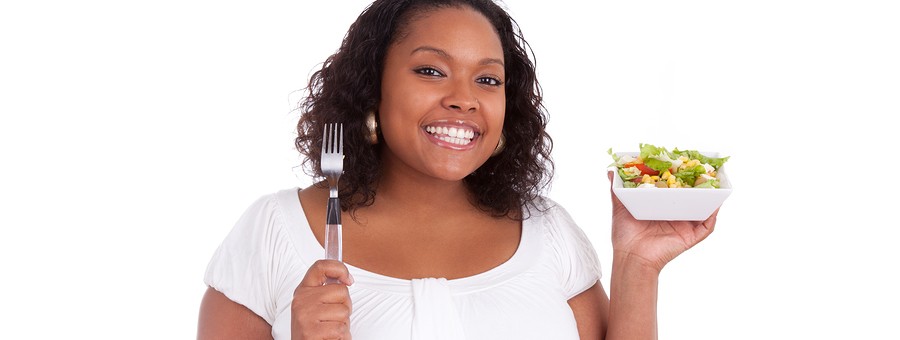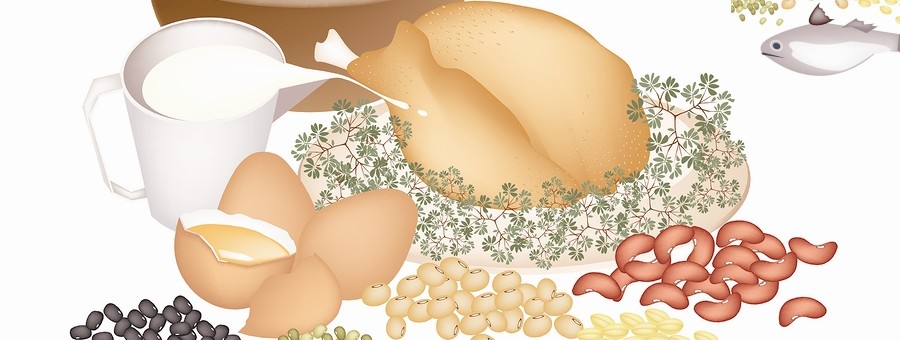There are big benefits to getting the right amount of protein after surgery–a strong immune system, healthy hair and nails, better weight loss and maintenance, strong muscles, peak energy, and improved appetite control.
While there is an abundance of benefits to meeting daily protein goals, not meeting them can have negative health effects—including weight regain. Getting the right amount of protein each day is all about food choices. It’s not hard to do, if you know what to do. Unfortunately, studies have found that many obtain less than 60 grams of protein a day. And one study found average protein intakes of just 42 grams a day.
Since, a major factor for maximizing weight loss success and promoting good health is getting the right amount of daily protein, let’s get this right.

Benefits to Getting the Right Amount of Protein
Protein for Good Health and Immune Function. Our bodies use protein to preserve muscle tissue, maintain nutritional status, increase feelings of fullness, support a healthy immune system and maintain weight loss.
In this era of COVID, many people supplement with things like vitamin C, zinc, elderberry, and vitamin D to support immune function. It’s important to realize that an optimal protein intake is essential for a peak performing immune system too.
Healthy Hair and Nails. It is not uncommon to see some hair loss 3-5 months after surgery. The main reasons for this are 1) the surgery itself and 2) the rapid weight loss that follows. These stressors cause more of the hair follicles to go into a resting state—then 3-5 months later that hair falls out. To prevent or lessen the severity of hair loss, meet daily protein goals and take vitamin and mineral supplements as recommended.
Keep Your Lean and Improve Health Outcomes. The goal of weight loss surgery is to improve health and reduce excess fat tissue. The reality is that some lean tissue (muscle) is also lost during the weight loss phase. If care is not taken, muscle can account for up to 31% of weight lost.
Reaching daily protein goals has been shown to reduce the amount of muscle tissue lost during weight loss. Not only does this impact weight loss and maintenance, but has many health implications as well. Maintaining muscle helps:
- Reduce the risk of falls
- Improve ability to walk and exercise
- Keeps your heart beating strong—remember the heart is a muscle too
- Reduce the risk of infections
- Regulate insulin and blood sugar
- Live longer—a higher ratio of muscle to fat improves life expectancy
- Muscle mass is the biggest factor impacting metabolism (the rate at which your body burns calories)
The bottom line: meet daily protein goals to minimize muscle loss and maximize fat loss. You’ll have better results from your surgery and improve your overall health as well.
Peak Energy
Muscle weakness and fatigue are signs of protein depletion. In addition to meeting protein goals daily, recommended vitamin and mineral supplementation and a healthy diet of fresh, unprocessed vegetables, fruits and whole grains is needed to optimize the body’s ability to process energy.
Improved Appetite Control
Eating six small, protein-rich meals help to reduce appetite. Hunger is not generally a factor immediately after surgery, but months after surgery, some may notice that their appetite begins to increase. An out-of-control appetite often signals a lower protein intake. Protein reduces levels of the hormone ghrelin that causes hunger. It also boosts appetite reducing hormones.
 Regular Exercise Helps Too
Regular Exercise Helps Too
When it comes to muscles, use them or lose them. A good diet will only get you so far, regular exercise is essential to maintaining muscle mass. Ideally, a program that includes both strength training and cardio (like a good brisk walk) is best.
In addition to maintaining muscle mass, regular exercise helps you lose weight and keep it off, keep bones strong, build strength, have greater endurance, improve balance, increase metabolism, boost energy and improved mood.
When you put the parts of a healthy lifestyle together, they build on each other. Regular exercise increases energy, confidence and mood. Those positive feelings help you select healthy foods. The combination of healthy food and exercise gives you more energy, more muscle mass, and a stronger heart. You improve your endurance and the ability to exercise. This wonderful synergy helps you build a healthy, fit body.
Track Your Intake
To assure you’re meeting your daily protein goal, track food and protein intake. This proven tool will help you reach your protein and weight loss goals. Use an app, a pencil and paper log, or create a spreadsheet. It’s easy to assume you’re meeting your goals, but tracking will give you the real scoop.
Where to Get Protein
The majority of protein should come from higher protein foods. These include lean meat/fish/poultry, low fat dairy and eggs, and beans. If protein goals are not met with food, protein drinks can fill in the gaps. Some people choose to start the day with a protein drink; others use them in the evening if their intake of high protein foods was lax on that day.
Liquid Phase
The volume of fluid that your body can handle is very limited during this phase, so it is especially important to use a concentrated source of protein to help meet your goal. Protein drinks fit this bill and work well for many people after surgery. Make sure the supplements you select have 2 grams or less of added sugar. Keep an eye on what you add to your protein drink so you don’t end up with more calories than you realize–use limited amounts of juice and peanut butter, and avoid adding sugar-free ice cream. Protein drinks are available in both ready-to-drink and powdered forms.
Pureed Foods
Once you start on the pureed food phase, you can add smooth-consistency foods to all of the liquid options.
Soft Foods
In addition to the liquid and pureed options, ground meats, flaky fish, eggs, low-fat cheese, and soft deli meats can now be used to help you reach your protein goal. At this stage, it is important to learn to take very small bites and chew food to a paste-like consistency before swallowing. Be sure to take a few small bites, pause and check your body signals for acceptance. Stay away from untoasted bread, rice, pasta and solid meats like steak, roast, pork chops, chicken breast, etc.
Regular Foods
Solid meats (chicken, pork, beef, etc) can now be added to the diet. High-protein foods (lean meat / fish / poultry and low-fat dairy products) may begin to replace protein drinks. Many people choose to include a protein drink daily as one of their six meals. Be sure to build your diet around high-protein foods and eat six small meals.

Six Small Meals
It’s best to divide protein between meals and snacks throughout the day. This doesn’t have to be exact and it can change based on your meal plan for the day. Here’s how it could look:
| Protein Goal | Breakfast | Lunch | Dinner | Each Snack (3) |
| 60 | 14 grams | 14 grams | 14 grams | 6 grams |
| 75 | 18 grams | 18 grams | 18 grams | 7 grams |
| 90 | 22 grams | 22 grams | 22 grams | 8 grams |
| 110 | 26 grams | 27 rams | 27 grams | 10 grams |
Mix and match the foods listed on the Best Foods to Meet Your Protein Goals chart below to meet your daily protein goals with ease.
Signs of Low Protein Intake
Meeting daily protein goals is certainly easier than correcting the bigger problems that build up from even small daily deficits. It can take months for signs of low protein intake to surface. If you fall short of your protein goal for a day or two, it is unlikely that you will notice any difference. But when you miss that goal day after day, symptoms seem to suddenly show up. Common signs of low protein intake include:
- Edema (swelling most often in the hands, arms, feet, ankles or legs)
- Thin, fragile, or loss of hair
- Low hand-grip strength
- Changes in appetite (nausea or increased hunger)
- Fatigue
- Loss of muscle mass
| The Best Foods to Help You Meet Protein Goals | ||||
| Full Liquid | Pureed | Soft | Regular | |
| Ready-to-drink protein shakes or protein water | x | x | x | x |
| Protein powders mixed with water or milk | x | x | x | x |
| Protein powders blended with fruit | x | x | x | x |
| Fairlife milk (higher in protein) | x | x | x | x |
| Milk, skim, 1% or 2% | x | x | x | x |
| Carbmaster white or chocolate milk (only at Kroger) | x | x | x | x |
| Carbmaster yogurt smoothies (only at Kroger) | smooth | x | x | x |
| Yogurt, Dannon Oikos Triple Zero | smooth | x | x | x |
| Yogurt, Dannon Two Good | smooth | x | x | x |
| Yogurt, Carbmaster (only at Kroger) | smooth | x | x | x |
| Yogurt blended with Fairlife milk and fruit | x | x | x | x |
| Yogurt, plain Greek, add fruit flavored protein powder | x | x | x | x |
| Pudding, no added sugar (ready to eat) | x | x | x | x |
| Pudding, instant mix – increase protein with Fairlife milk or protein powder | x | x | x | x |
| Soup, blended and strained | x | x | x | x |
| Soup, blended | x | x | x | |
| Soup, add extra chicken or meat, blended | x | x | x | |
| Soup | x | x | ||
| Soup, add extra chicken or meat | x | x | ||
| Chili, (beef, turkey, chicken, vegetarian) blended | x | x | x | |
| Chili, (beef, turkey, chicken, vegetarian) | x | x | ||
| Hot cocoa, no added sugar, made with milk | x | x | x | x |
| Fudgesicles, no added sugar | x | x | x | x |
| Carnation Instant Breakfast, no added sugar | x | x | x | x |
| Refried beans, mashed | x | x | x | |
| Refried beans | x | x | ||
| Cottage cheese, mashed | x | x | x | |
| Cottage cheese | x | x | ||
| Low fat gravy blended with meat | x | x | x | |
| Egg substitute (Egg Beaters), lightly scrambled | x | x | x | |
| Eggs (scrambled, fried, hard or soft boiled) | x | x | ||
| Tuna, add seasoning and light dressing, finely chopped | x | x | x | |
| Tuna, add seasoning and light dressing | x | x | ||
| Tuna, add fresh celery, onion and light dressing | x | |||
| Chicken, canned, add seasoning and light dressing, finely chopped | x | x | x | |
| Chicken, canned add seasoning and light dressing | x | x | ||
| Chicken salad with fresh vegetables | x | |||
| Meat, fish or poultry blended | x | x | x | |
| Meat or poultry, ground or finely shredded | x | x | ||
| Fish, flakey, baked | x | x | ||
| Meat, fish or poultry (moist and tender is best) | x | |||
| Deli meat (lean turkey, chicken, ham, or roast beef) | x | x | ||
| Hummus | x | x | x | |
| Beans, mashed (avoid baked beans with added sugar) | x | x | x | |
| Beans (avoid baked beans with added sugar) | x | x | ||
| Vegetarian burgers | x | x | ||
| Vegetarian meat substitutes | x | x | ||
| Tofu | x | x | ||
| Turkey sausage | x | |||
| Cheese, low fat (light mozzarella cheese sticks, light Baby Bell, Light Laughing Cow, 2% milk cheese) | x | x | ||
| Protein bars, low sugar – great for emergencies | x | |||
| Peanut butter, smooth, in liquid recipes (limit due to high fat) | x | x | x | x |
| Peanut butter, smooth (limit due to high fat) | x | x | x | |
| Powdered peanut butter, in liquid recipes | x | x | x | x |
| Powdered peanut butter | x | x | x | |

